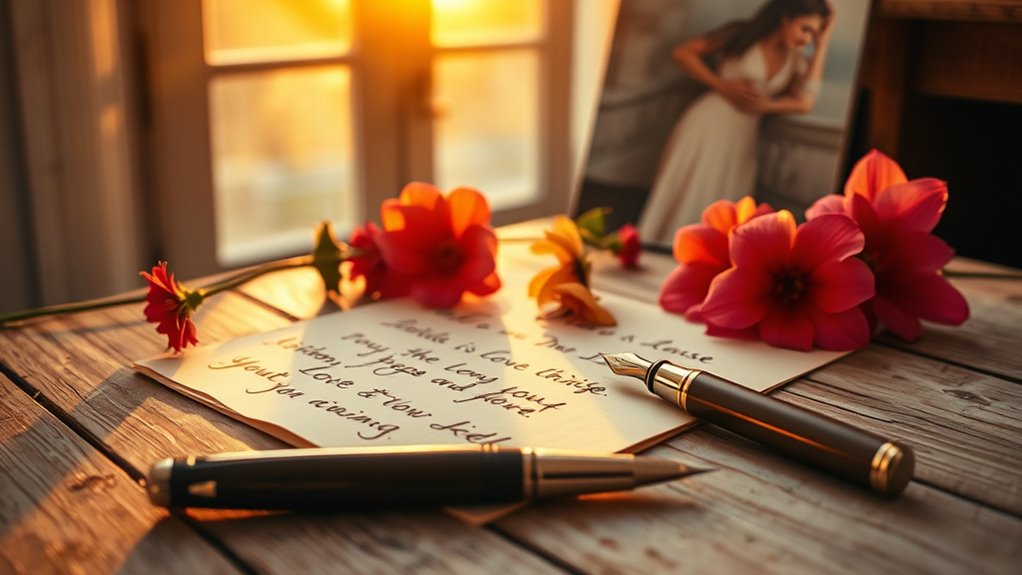Filipinas cherish handwritten letters in love because they convey deep emotions and a personal touch that digital messages can’t match. These letters symbolize meaningful connections and reflect cultural values, blending traditions with heartfelt expression. They become cherished keepsakes, often passed down as family heirlooms that tell stories and connect generations. The act of writing fosters mindfulness and creativity, enhancing the sentiment behind the message. You’ll discover even more reasons behind this enduring tradition.
Key Takeaways
- Handwritten letters convey deeper emotional engagement, fostering intimate connections that resonate more profoundly than digital messages in Filipino culture.
- Personal touches, like doodles or pressed flowers, enhance the sentimental value of letters, making them cherished keepsakes.
- Letters serve as family heirlooms, connecting generations and preserving shared experiences and cultural values.
- The act of writing letters enhances cognitive skills and creativity, nurturing emotional expression and communication.
- Handwritten letters leave a lasting legacy of love, capturing significant moments and providing comfort during challenging times.
The Personal Touch of Handwritten Letters
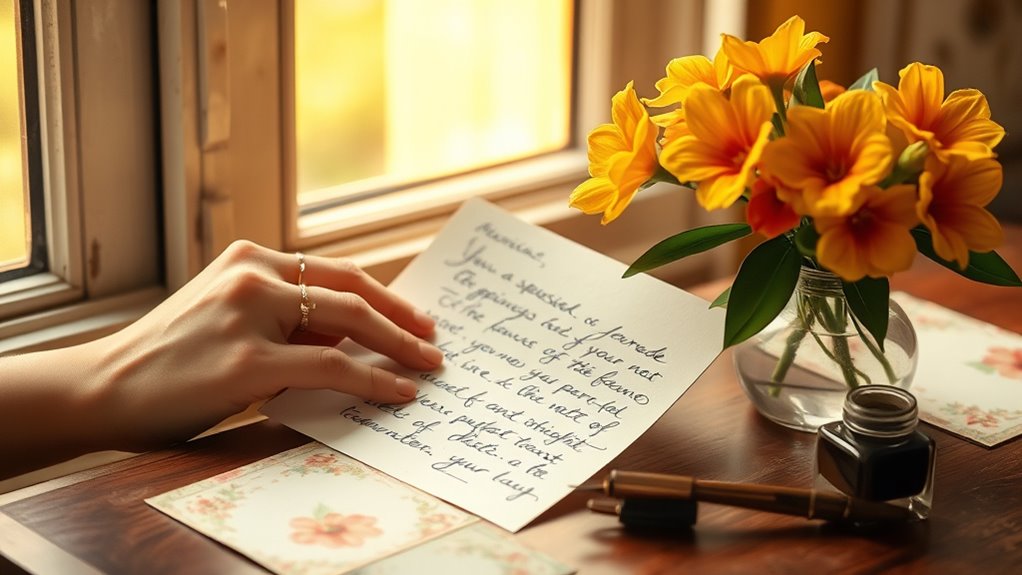
Although digital communication has become the norm, there’s something irreplaceable about the personal touch of handwritten letters. Each person’s handwriting acts like a fingerprint, making your message uniquely yours.
The physicality of a handwritten letter engages the senses, adding an intimate element that digital messages simply can’t replicate. When you take the time to write, it shows you care, reflecting the thought and effort invested in your words.
Personal touches, like doodles or pressed flowers, enhance this uniqueness, making your letter feel heartfelt. Plus, these tangible keepsakes can be cherished for years, evoking emotions like nostalgia and joy.
Handwritten letters truly capture the essence of personal connection, reminding recipients of the love and thoughtfulness behind your words.
Emotional Depth and Connection
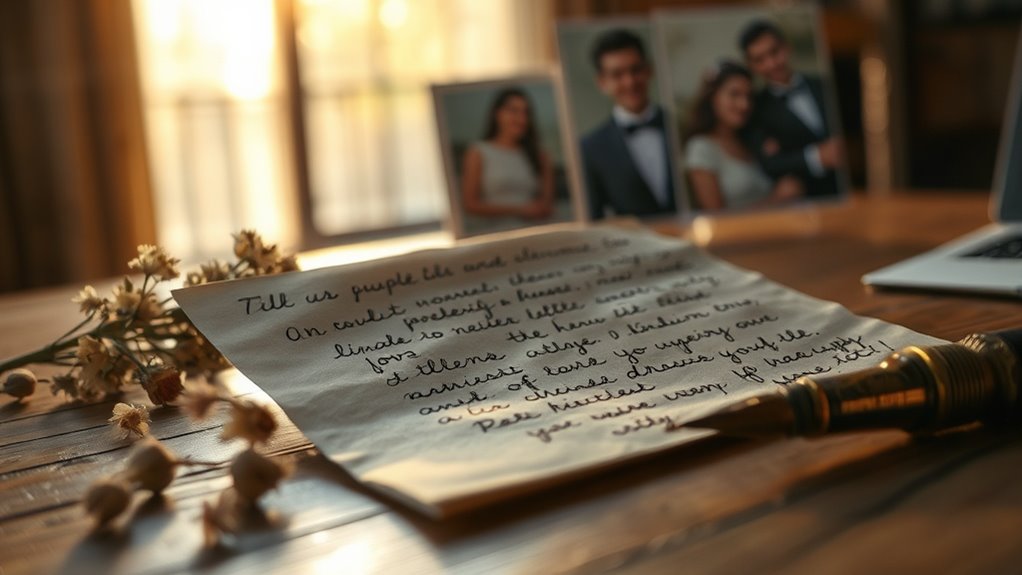
When you pour your feelings into a handwritten letter, you create an intimate space for emotional depth and connection that digital messages often lack. The vulnerability of sharing your emotions through your own handwriting fosters a unique bond. As you invest time and effort into crafting each word, you emphasize the importance of your relationship, making your sentiments more memorable. The physical act of writing conveys emotions more intensely, capturing nuances that typed messages can miss. Each letter reflects your personality, adding layers of sincerity and authenticity. This personal touch deepens understanding and cultivates trust, making your connection stronger. Additionally, the challenges of maintaining privacy and boundaries in relationships can be alleviated through such heartfelt expressions. Furthermore, the emotional damage caused by virtual affairs can be mitigated by fostering genuine connections through personal communication. Ultimately, handwritten letters become cherished tokens of love, preserving emotional moments that last a lifetime.
Cultural Significance in Filipino Communication

Handwritten letters hold a special place in Filipino culture, serving as a powerful means of communication that fosters personal connections. They symbolize deeper emotional engagement, reinforcing your ties with loved ones.
When you write, you express your thoughts and feelings more profoundly than with mere words. Personal letters often weave in cultural references and idioms, highlighting shared heritage and values, which strengthens your cultural bond.
This correspondence preserves language and traditions, especially among younger generations. Additionally, the use of formal language in letters reflects respect for hierarchy, emphasizing the importance of honoring elders.
Ultimately, handwritten letters become cherished mementos, serving as lasting reminders of relationships and the love that binds you together.
Handwritten Letters as Family Heirlooms
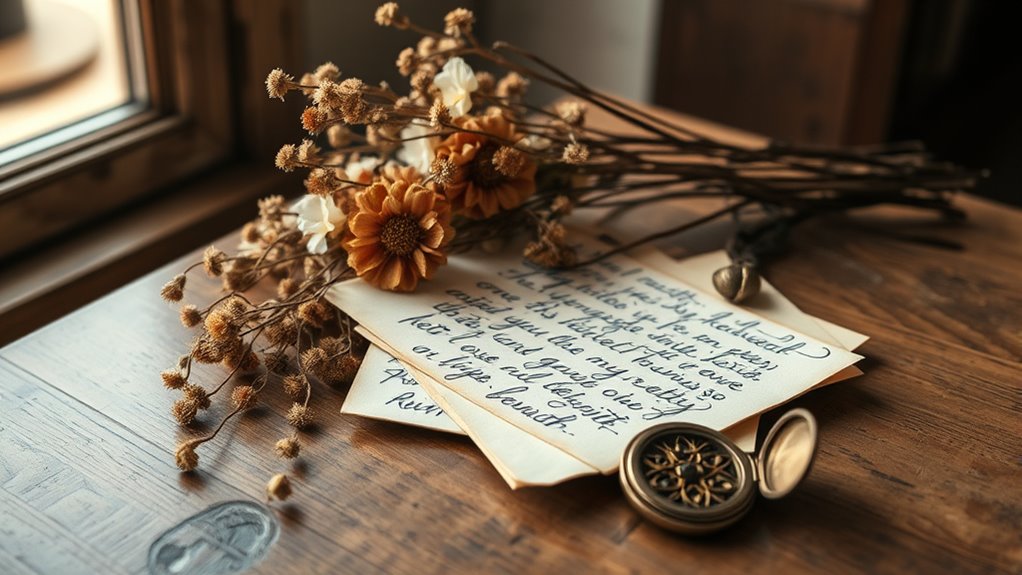
As families gather to reminisce about cherished memories, handwritten letters emerge as invaluable heirlooms that connect generations.
These letters evoke deep emotions, offering tangible reminders of love and shared experiences. The physical act of writing creates an intimacy that digital messages can’t match, enriching family narratives.
Handwritten letters document personal milestones and insights into past generations, preserving family history and cultural values. Their unique characteristics, like varied handwriting and paper types, enhance their sentimental value.
The Art of Storytelling Through Letters
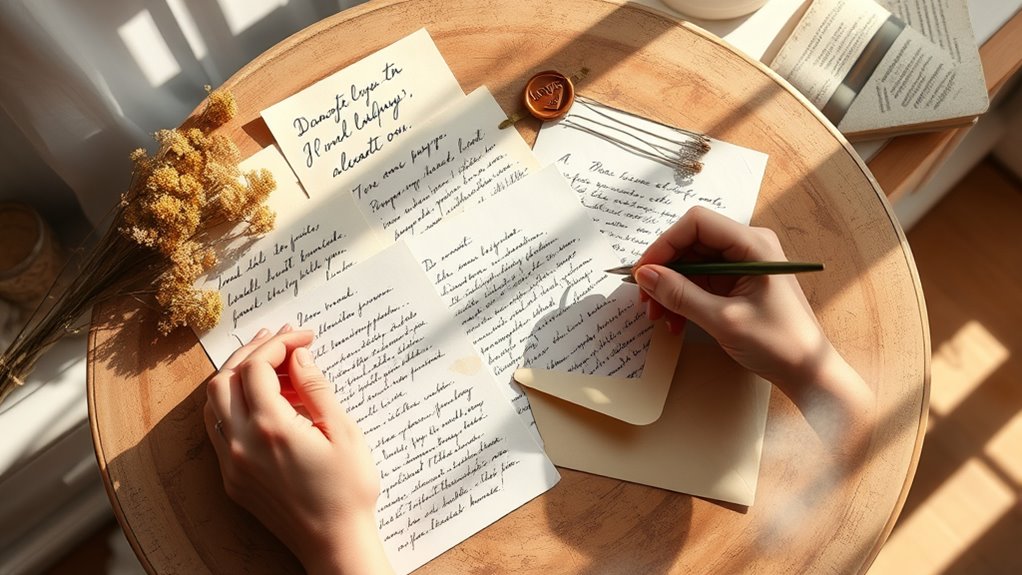
Though often overlooked in today’s fast-paced digital age, the art of storytelling through letters offers a profound way to connect with emotions and experiences. When you write a letter, the tactile feel of paper and ink allows your sentiments to resonate more deeply. Establishing healthy boundaries can also enhance the intimacy of letter writing, as it encourages honest expression without the pressure of immediate response.
Personal touches like doodles or unique handwriting styles create a bond that digital messages can’t replicate. Letters can share diverse perspectives, revealing contrasting emotions that enrich relationships. They invite readers into intimate thoughts, fostering empathy for characters’ journeys.
This storytelling format not only enhances world-building but also encourages creativity, inspiring you to appreciate communication’s charm. By embracing handwritten letters, you can savor the beauty of slow, deliberate storytelling that truly connects hearts. Additionally, the role of contrast ratio in visual storytelling can be likened to the emotional depth found in handwritten letters, as both enhance the overall experience through vivid and relatable imagery.
Nostalgia in the Digital Age

In an era dominated by instant messaging and social media, you might find yourself reminiscing about the simpler times when a handwritten letter held the weight of genuine connection.
There’s something special about the tangible emotion of a letter, offering a physical link to the sender and preserving memories that digital messages can’t replicate. The effort you put into crafting a letter conveys a deeper level of care, creating a unique experience that builds anticipation.
The tangible emotion of a handwritten letter creates a unique bond, preserving memories and conveying heartfelt care like no digital message can.
Each note reflects your personality and thoughtfulness, evoking warmth and nostalgia. While digital communication has become convenient, it often sacrifices intimacy.
As you reflect on these moments, you may feel inspired to embrace handwritten letters, enriching your connections in this fast-paced digital age.
Mindfulness in the Writing Process
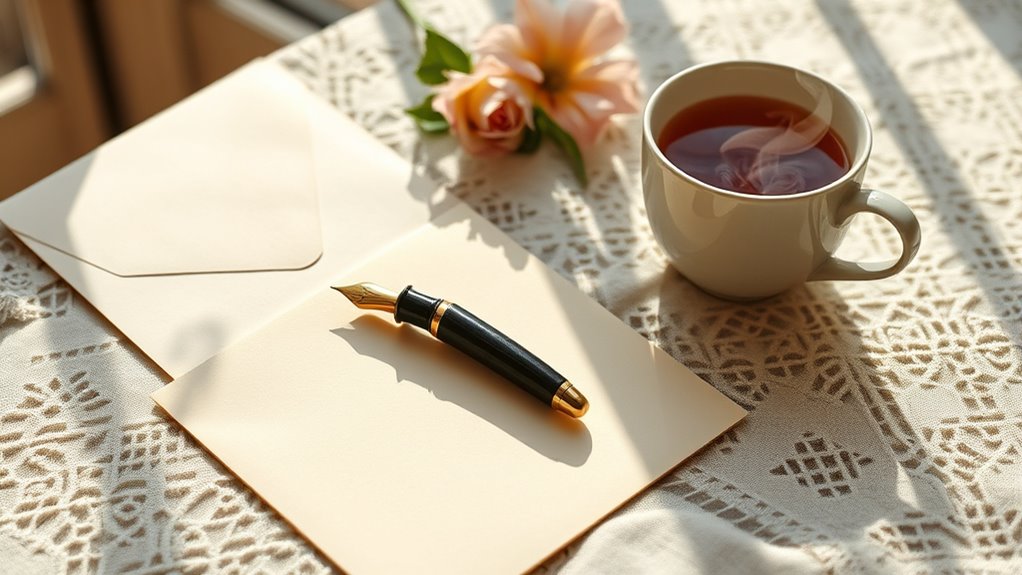
Mindfulness transforms the writing process by grounding you in the present, allowing for a deeper connection to your thoughts and emotions. By focusing your attention, you reduce stress and enhance mental clarity, making writing feel more therapeutic. Engaging in self-care routines can further support your mental health during this creative journey. Incorporating omega-3 fatty acids into your diet can also support cognitive function, which may enhance your writing experience. Additionally, practicing aromatherapy techniques can create a calming atmosphere that fosters creativity. Using essential oils like lavender oil can promote relaxation, enhancing your ability to focus on your writing.
Engaging in breathing exercises can foster calmness, helping you tap into your authentic voice. Creating a serene environment further promotes focus, enabling you to explore your feelings more deeply. As you embrace mindfulness, your creativity blooms, opening doors to new ideas and perspectives. With regular practice, you’ll find that your writing becomes more emotionally resonant, transforming the process into a fulfilling artistic experience. This aligns with the principles of secure attachment bonds, which enhance emotional health and relational wisdom.
Mindfulness not only enriches your work but also nurtures your overall emotional well-being.
Reviving Indigenous Writing Traditions

As you explore the rich tapestry of Filipino culture, reviving indigenous writing traditions like Baybayin offers a powerful way to reconnect with your roots.
Baybayin, part of the Brahmic script family, was historically used in Tagalog and Kapampangan areas, inscribed on palm leaves or bamboo. Although Spanish colonization led to its decline, modern efforts aim to restore this unique script, highlighting its cultural significance. Sustainable foraging practices can also inspire creative expressions of heritage, as they promote a deep respect for natural resources and traditional knowledge. Engaging in such practices can also enhance biodiversity by fostering an awareness of the environment and its importance to cultural heritage. The revival of writing traditions, along with the trend of minimalist living, encourages a return to simplicity and authenticity in daily life. Moreover, embracing these traditions aligns with effective preparation for cultural preservation initiatives. In addition, incorporating organic farming techniques into community workshops can further emphasize the connection between culture and sustainable practices.
By incorporating Baybayin into art and community workshops, you’ll engage in preserving Filipino identity and history. This revival not only honors your ancestors but also fosters a sense of belonging, as you participate in reclaiming and celebrating your heritage.
Embracing Baybayin enriches your understanding of Filipino culture and strengthens your connection to the past.
Handwritten Letters as Educational Tools
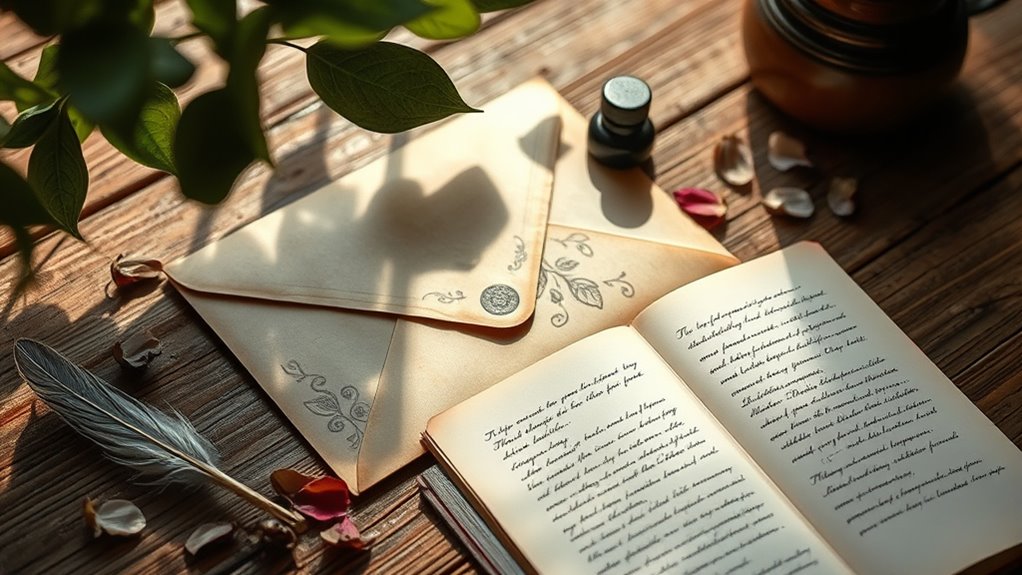
Handwritten letters serve as powerful educational tools, enhancing cognitive development and memory retention in learners. When you write by hand, your brain forms stronger neural connections, improving your ability to remember information. This deeper cognitive engagement helps you retain more than if you typed.
Practicing handwriting also boosts fine motor skills, essential for overall coordination. As you form letters, your brain actively encodes information, making handwritten notes more memorable. Plus, the tactile feedback from writing enhances mental associations with the material.
Engaging in handwriting fosters creativity, allowing you to express your thoughts uniquely. This personal touch not only enriches your learning experience but also supports literacy development, ensuring you grasp essential skills for academic success.
Preserving Love and Relationships Through Letters
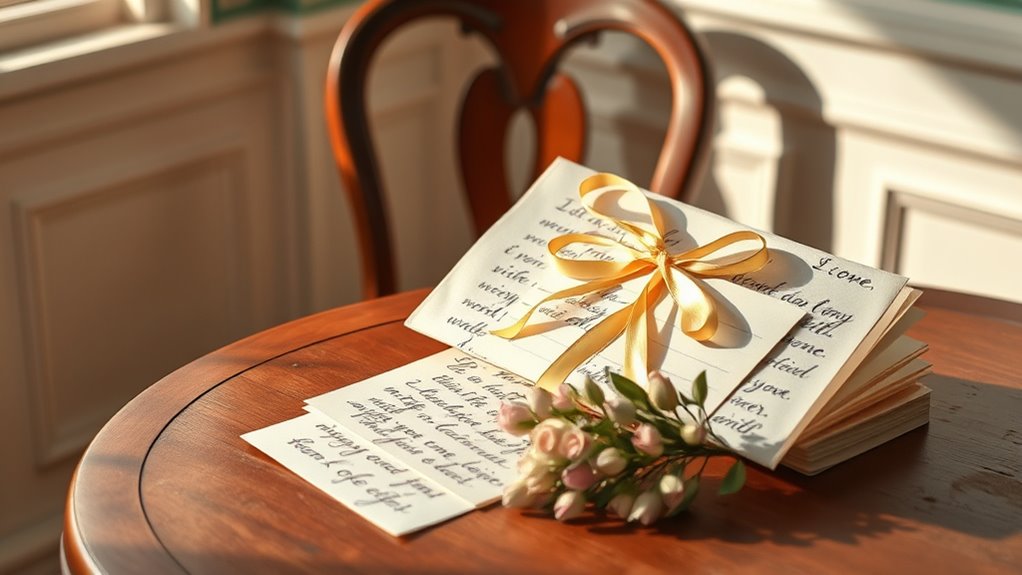
While many forms of communication have evolved in the digital age, handwritten letters remain a heartfelt way to preserve love and relationships. When you put pen to paper, you create a unique emotional connection, allowing your true feelings to shine through.
The personal touch of your handwriting and the feel of the paper evoke nostalgia, making every letter special. By sharing your vulnerabilities, you deepen intimacy and reflect on the evolution of your relationship.
The unique essence of your handwriting and the tactile experience of paper create nostalgic connections, enriching intimacy and reflecting your relationship’s journey.
These letters capture profound moments, serving as treasured keepsakes for years to come. In challenging times, they provide comfort and reassurance, reminding your loved one of their importance.
Ultimately, handwritten letters leave a lasting legacy of love, bridging the past with the present. Furthermore, the act of writing fosters authenticity and existence, enhancing the emotional depth of your messages.
Frequently Asked Questions
How Do Handwritten Letters Compare to Other Forms of Communication?
Handwritten letters stand out compared to digital forms of communication because they convey emotions more deeply.
You feel the personal touch in each stroke of the pen, making the message memorable. Unlike quick emails or texts, a handwritten note shows effort and sincerity, fostering a stronger emotional connection.
You’re likely to cherish it more, as it evokes feelings of gratitude and obligation to respond, creating a lasting impact that digital messages often lack.
What Materials Are Best for Writing Handwritten Letters?
You’d think any scrap paper and a pen would do the trick for handwritten letters, right?
But choosing the right materials can elevate your message. Opt for Clairefontaine Triomphe for its smoothness, or try Midori MD for that unlined creativity.
Pair it with a fountain pen for a refined touch, or a gel pen for vibrant flair.
And don’t forget matching envelopes—they’re the cherry on top of your heartfelt correspondence!
Are There Any Etiquette Rules for Writing Handwritten Letters?
When writing handwritten letters, you should follow certain etiquette rules to guarantee clarity and respect.
Start with a clear greeting and indent each new paragraph. Keep your handwriting legible—if it’s difficult to read, consider including a typed version.
Use nice stationery, and add a personal touch to the envelope.
Conclude with a proper closing, like “Sincerely” or “Love,” and consider timing to make your message more meaningful.
How Can I Start Writing My First Handwritten Letter?
To start writing your first handwritten letter, first, choose quality stationery that reflects your personal style.
Grab a comfortable pen and find a quiet space to focus.
Begin with a personal greeting, using a nickname or endearing term.
Express your genuine feelings by sharing memories or compliments.
Conclude with a heartfelt statement and consider adding a small personal touch, like a doodle.
Finally, proofread to guarantee clarity before sending it off.
What Are Common Themes in Love Letters Throughout History?
Throughout history, common themes in love letters often revolve around deep emotional connections, longing, and sincerity.
You’ll notice expressions of desire, admiration, and vulnerability, as writers reveal their innermost feelings. Many letters utilize poetic language, metaphors, and imagery to create vivid emotional landscapes.
Themes of separation, devotion, and the passage of time frequently emerge, reflecting societal norms and personal experiences that resonate across different cultures and eras, making them timeless treasures.
Conclusion
So, next time you’re tempted to send a quick text or emoji, remember the charm of a handwritten letter! Sure, it might take you longer to find a pen and paper than to tap out a message, but who doesn’t want to channel their inner Shakespeare? Embrace the art of slow communication; after all, nothing says “I love you” like a crumpled piece of paper stuffed in an envelope that probably smells like your grandma’s old perfume.
